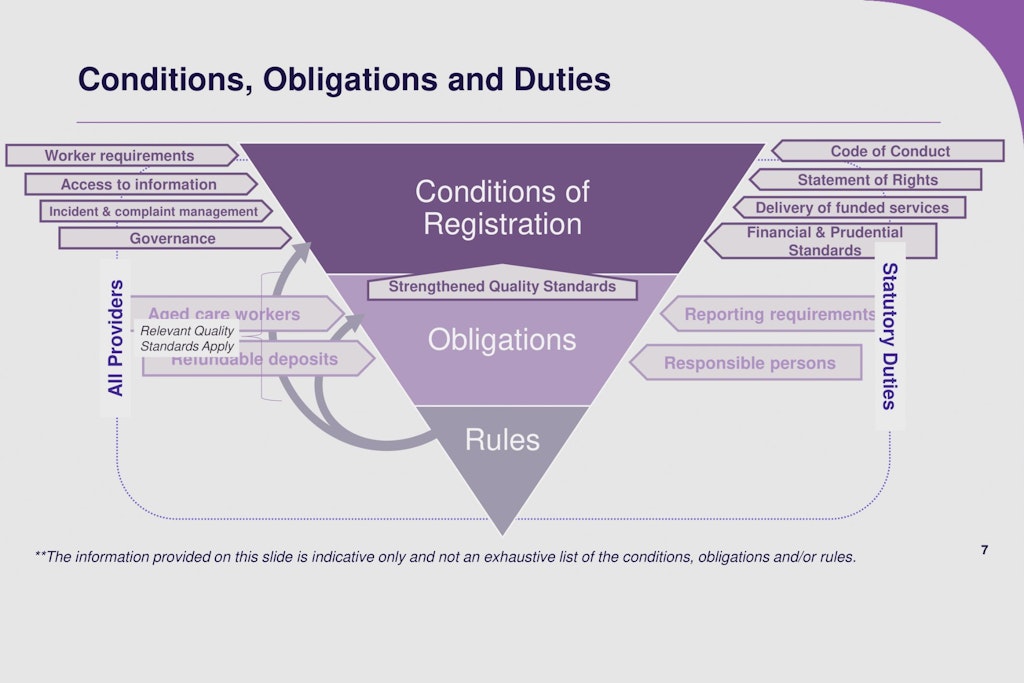Rules, obligations, and frustrations: Gov webinar explores new regulatory model
Last updated on 8 May 2025

The Department of Health and Aged Care has delivered a timely update about the Aged Care Act’s new regulatory framework, exploring the fundamental elements of the new Act, and some of the sector’s burning questions — and frustrations.
Key points
- Currently, hundreds of provider responsibilities are spread across several pieces of legislation. These responsibilities will change under the new Act, as the new regulatory model streamlines regulatory requirements under: conditions, obligations and statutory duties.
- There will be requirements that apply to all registered providers, including the Rights & Principles, Code of Conduct and reporting requirements, alongside features such as worker screening and provider cooperation.
- While the new regulatory model is still complex, providers can access a Digital Provider Obligation tool that will include details about requirements, including service types, registration categories and obligations topics.
- Providers are registered under the new Act on day one, July 1, and will have until June 1 to update relevant details to ensure the new registration is accurate.
Understanding the regulatory basics
Rob Day, Assistant Secretary, Harmonisation and Regulatory Strategy Branch, began by outlining the reform journey so far before offering a brief summary of the regulatory basics.
He explained that many of the requirements in existing legislation have been added over the better part of 30 years, meaning the new Act not only modernises them, but refines them under one document.
He outlined the three key regulatory requirements of the Act for registered providers, starting with conditions of registration. This covers the Code of Conduct, Statement of Rights, delivery of services, financial and prudential standards, governance, the strengthened Aged Care Quality Standards, and more. Many conditions will apply to all providers, while some apply to ‘providers of a kind’ (such as a government entity) or even individual services.
Obligations offer more specific provider expectations, such as reporting requirements, suitability of responsible persons, aged care worker requirements, and the aged care worker requirement to comply with the Code of Conduct.
Finally, there are statutory duties. All provider organisations must ensure that their actions or inactions do not result in harm or injury to the person receiving care. Responsible persons of organisations need to exercise due diligence to ensure that their organisation meets that duty.

Mr Day said there is a clear link between the requirements trio, and they are all designed to help providers meet their fundamental duty of avoiding doing harm to the people they are caring for.
Critically, if an organisation receives a government-subsidy for delivering a service, that organisation is responsible for meeting the relevant obligations, even if another organisation is assisting with its delivery.
A new tool outlining your obligations
The new Aged Care Act delivers a high dose of confusion. Luckily, the department is designing an interactive online web tool where providers can view all of their relevant obligations, conditions and duties.
“You’ll be able to navigate the tool using filters and specific search criteria to produce a list of all the obligations relevant to your individual circumstances and download the output for later use,” Simon Christopher, Director, Regulatory Model Strategy Section, explained.
“Similar to a website where you can get a quote based on the selections, this tool will ask the user to choose from a list of options and relevant obligations will be shown dependent on the option Key filters will include registration categories program types such as CHSP or support at home to see any obligations based on the funding or the particular registration category.
“There will be pop-up links referencing the Act and Rules on the federal register of legislative instruments, allowing the user to validate their findings against the original source information as needed.”

The tool will link to relevant education and guidance materials on the department’s website.
Mr Christopher also provided an update on the worker screening check that seeks to improve protections for older people and make it easier for registered providers and workers to comply.
There will be minimal changes to worker screening when the new Act commences, meaning workers can continue to rely on existing police checks and relevant certificates. While there will be some changes for Commonwealth Home Support Program (CHSP) providers on July 1, other widespread changes will not commence before 2026.
Organising provider registration
Providers will transition from their current state as a grandfathered provider or an approved provider to a new state under the Act as a registered provider. This process is already under way, and providers should have received a provider registration preview or a request for consent and nomination for contact details.
“Deeming is a legal process that will happen automatically on the first of July to take you from that current state to that new state. We’ve been working through an iterative process to make sure that the way we represent that in our data systems is accurate and reflects your business correctly,” Mr Day explained.
For providers that have recently been accredited, there will be details in the document about relevant registration expiry dates, what registration categories a provider will likely be deemed into, the services delivered and all homes associated with the registration.
Any organisation that has not received this document or email should contact [email protected] before June 1 to ensure there is no information that needs to be updated before the data changeover on June 30.
Frustration rises to the surface
The webinar dedicated the last 30 minutes to the top viewer questions, revealing just how much pressure providers are under as frustration reached a tipping point.
Q: Will there be a delay in support at home given the rules have not been finalised?
A: Amy Laffan, First Assistant Secretary, Quality and Assurance Division, explained that any decision on timing or delay for the new Act and relevant reforms is a matter for the government itself. She said that although the rules are not finalised, wholesale changes are unlikely, while important Support at Home information such as service agreements requirements have been published.
“We’re working really closely with the transition taskforce and we’re working on issues exactly like this one, so that we can understand where the pain points are and provide the best information we can to the sector. We are looking at options for draft or template service agreements or addendums which would help providers,” Ms Laffan added.
More information and guidance around service agreements is expected to be released in the coming weeks.
Another question focused on providers being delayed with their transition because key documents are still being finalised. They said the department is not meeting its obligations.
“We treat our obligations very seriously, but I acknowledge your comment about the pressures and the timing,” Ms Laffin said.
She went on to say providers should not rely on information being finalised and that current information, including drafts, should help providers prepare without fearing that major changes to rules and regulations will occur.
Ms Laffin said the department will look at providing documents that clearly highlight the changes released to the public. An index that clearly outlines what information has been published and is most up to date is also on the radar.
Q: When can we expect the Rules to be released?
The Rules will be released as soon as ministerial positions in the re-elected government are finalised. Ms Laffin reaffirmed that they will be largely unchanged as part of the implementation.
Q: Why has the consultation on the rules been left to the 11th hour given such high density? Is this a strategic move to cause burnout or so that we miss details?
With provider frustrations reaching boiling point, Ms Laffin explained that the Rules have been released over several consultation periods since November. She stated the staged release reduced pressure on provider responses.
Feedback so far is likely to be more ‘editorial’, while there are some changes the government will have to decide on once it resumes.
More information, including the webinar slides and recording, can be found here.